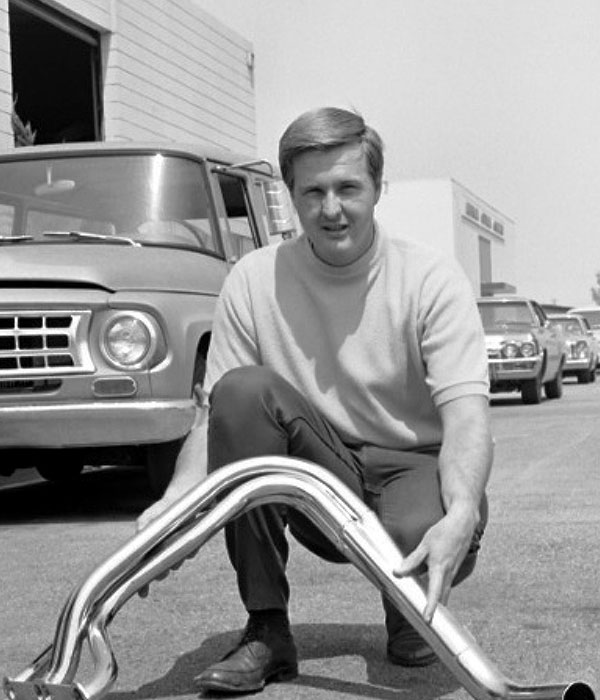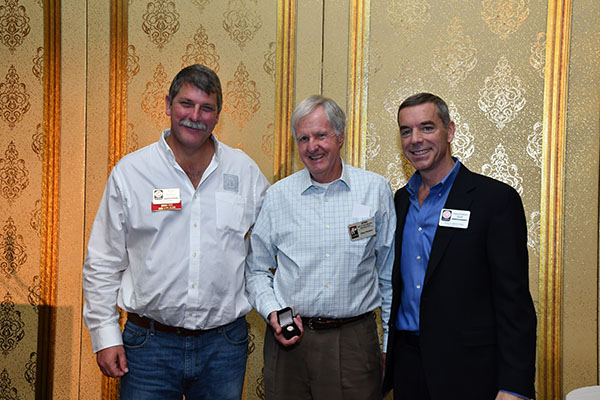2016 SEMA Hall Of Fame Inductee

Gary Hooker
Hooker Headers
You may not know very much about inductee Gary Ronald Hooker, which is a bit remarkable, given that Hooker Headers is one of the aftermarket industry’s most iconic names.
Hooker’s story began in Sioux City, Iowa, but the family moved to Pomona, California, when he was about five years old. His father was a lay minister, so Hooker grew up in a very religious household. Because the family was poor, he didn’t have much to play with, but a neighbor usually had a copy of Hot Rod or Popular Mechanics on hand, so he was very interested in cars from the earliest age.
“At eight years old, I could name any car,” Hooker said. “From when I can remember, I was also always mechanically inquisitive.”
Proof in point: At age 10, he bought his first bicycle for $10 and had to rebuild it, which “was a natural thing.”
His high school had an industrial-arts department that included auto shop and machine shop, “so I took advantage of that.” He also began to rebuild engines for friends—although his real passion was sports. He played baseball, football and basketball. (As an adult, he has been an avid skier, a dirt-bike rider, a cross-country runner, a multisport endurance athlete and an avid backcountry explorer.)
Hooker also had an affinity for design. “I drew cars a lot,” he said. “I’d even make up cars. I was always modifying them in the drawings.”
From that, an interest in racecars was born. His first car was a ’40 Ford with a flathead engine fitted with a ¾-race cam. He paid $175 for the car, thanks to a part-time job. He tore it apart and did a full restoration.
After high school and junior college, Hooker volunteered for the draft but was talked into joining the National Guard, where he did six months of active duty. After that, around age 20, he went to work as an electronics technician for General Dynamics, which meant that he could afford a new ’62 Chevy 409.
Two hours after he brought it home, the cylinder heads were off. And then history happened: Hooker couldn’t afford to buy headers, so he made his own. His secret was to make the headers longer and the tubing larger than what was already available.
Prior to racing the car, Hooker took it to Jack Bayer to have it dyno-tuned, and when he arrived, Bayer had just finished with the dyno on a customer’s car he had built—with the same motor as Hooker’s. But Hooker’s car made more horsepower.
“Jack said to me, ‘It’s got to be those headers,’” Hooker said. “’Can you get me some of those?’ I told him, ‘No, those are the only ones I’ve made. But if you give me a ride home, we can take the headers off my car and put them on your 409.’”
That night, with Hooker’s headers, the customer’s car raced a couple of mph faster and a tenth quicker.
“I more or less went into business right then,” Hooker said.
He sold the car to buy equipment to start building headers—while still living at home. But he rented a small shop in 1964, and racer Elwin Westbrook came in to share the space. Elwin built racecars while Hooker built headers. Within a few months, “six of the top 10 Super Stock racers had my headers.”
This was also around the time when he had a booth at the first SEMA Show. His wife, Gail, was eight months pregnant (they went on to have three children) and worked the Hooker Headers table, even though they didn’t have catalogs yet.
“We weren’t really even in business,” Hooker said. “We went by the finance company and borrowed money so we could go to the show.”
Not long after that, Gil George knocked on Hooker’s door asking for a job.
“Gil and I were collaborators and did some amazing things with designing and building headers,” Hooker recalled. “These rich guys would drive their Jeeps out in the morning, and Gil would take the right side and I’d take the left side, and we’d be done by noon. I charged them $150, and that kind of fed our families for a week.”
In the summer of 1965, Hooker rented a larger shop, but faulty welding cylinders exploded one night, and it burned to the ground. Hooker had no insurance. His neighbor, Bill Casler, who was already known for his racing slicks, “came to my rescue and we formed a partnership. He put in money and bought half the business.”
From 1966 to 1969, Hooker Headers grew from a $100,000 business to $3 million.
“By about 1970, we had established ourselves in our industry,” Hooker said. “I think I was successful because I changed early on from having an emphasis on racing to an emphasis on building the product. It was always a customer-driven company. We tried to have direct contact with the customer. That was a philosophy that was developed early, and we stuck with it.”
Hooker sold Hooker Headers to Holley Performance Products in 2000.
Gary Hooker is a man who will constantly reference others in the industry and within Hooker Headers who helped him find success. “Collaborating energy” is what he calls it.
“A lot of people in the industry don’t even know there’s a Gary Hooker,” he said. “People know about Hooker Headers because of many skilled people who were there at the right time. This SEMA Hall of Fame award is a salute to those people who worked together each day to do the thousands of jobs that led to the success. People come into your life, and they aren’t always necessarily friends. But they touch your life. I feel like I don’t deserve this honor. But those people do.”


